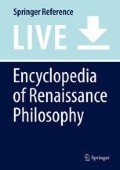Abstract
The concept of life has always served as an idea integrating thoughts on this world and the afterlife, on the physical and the spiritual existence. Thus, it has been a subject in the humanities as well as in the natural sciences. As a consequence, the term has always been ambiguous. For the natural sciences, Aristotle laid the foundation by identifying functions such as nutrition, growth, reproduction, and perception as criteria for the definition of life, while recognizing that this plurality of criteria resulted in “being alive” meaning different things to different beings (thus turning the term into a “homonym”). In the Middle Ages, the concept was integrated into Christian theological thought and took on a strongly dualistic meaning: the “real” or “true life” was now the eternal life, while the “mortal life” of animals and nonbelievers became a second, lesser category. Consequently, Christian thinkers showed little interest in the efforts to explain the phenomena of life by the natural sciences. This situation changed in the twelfth century with translations of Aristotle’s works into Latin which brought attention back to the organic aspects of life. Scholars opened their minds to the knowledge of craftsmen and artisans such that the concept of life developed within a complex network of communication between individuals from theoretical and more practical backgrounds. By this movement, physiology was gradually taken out of theological and medical contexts and considered in its own right. With the emergence of the natural sciences in the early seventeenth century, mechanistic and quantitative analyses were introduced into the study of living beings. While trying to explain the processes of life mechanically, most authors of the time retained the Aristotelian idea of living beings as substantial forms.
References
Primary Literature
Clauberg, J. 1654. Logica vetus et nova. In Opera omnia philosophica, vol. II, 765–904. Amsterdam: Blaeu 1691.
Clauberg, J. 1656. De cognitione Dei et nostri, Exercitationes centum. In Opera omnia philosophica, vol. II, 585–764. Amsterdam: Blaeu 1691.
Descartes, R. 1632. Traité de l’homme. In Œuvres de Descartes, eds. C. Adam, and P. Tannery, vol. XI, 119–202. Paris: Vrin 1986.
Digby, K. 1644. Two treatises in the one of which the nature of bodies, in the other, the nature of man’s soule is looked into. Paris: Blaizot.
Harvey, W. 1628. Exercitatio anatomica de motu cordis et sanguinis in animalibus. Francfurt: Fitzer.
Malpighi, M. 1661. De pulmonibus. Bononiae: Ferronius.
More, H. 1659. The immortality of the soul. Dordrecht: Springer 1987.
Paracelsus. 1526–1527. De vita longa. In Sämtliche Werke, ed. K. Sudhoff and I. Abt, vol. 3, 247–92. München: Oldenbourg 1930.
Perrault, C. 1683. Mécanique des animaux. In Oeuvres diverses de physique et de mechanique, vol. 1. Leiden: van der Aa 1721.
Santorio, S. 1614. De medicina statica. Venetiis.
Spinoza, B. 1677. Ethica, ordine geometrico demon-strata. Amsterdam.
Vesalius, A. 1543. De humani corporis fabrica. Basileae: Oporinus.
Secondary Literature
Des Chene, D. 2000. Life’s form. Late Aristotelian conceptions of the soul. Ithaca: Cornell University Press.
Duchesneau, F. 1998. Les modèles du vivant de Descartes à Leibniz. Paris: Vrin.
Ingensiep, H.W. 2001. Geschichte der Pflanzenseele. Philosophische und biologische Entwürfe von der Antike bis zur Gegenwart. Stuttgart: Kröner.
Perfetti, S. 2000. Aristotle’s zoology and its renaissance commentators (1521–1601). Leuven: University Press.
Pichot, A. 1993. Histoire de la notion de vie. Paris: Gallimard.
Quarantotto, D. 2010. Aristotle on the soul as a principle of biological unity. In Was ist,Leben‘? Aristoteles Anschauungen zur Entstehung und Funktionsweise von Leben, ed. S. Föllinger, 35–53. Stuttgart: Steiner.
Schaede, S., and P. Bahr. (eds.). 2009. Das Leben, I. Historisch-systematische Studien zur Ge-schichte eines Begriffs. Tübingen: Mohr Siebeck.
Toepfer, G. 2011. Historisches Wörterbuch der Biologie. Geschichte und Theorie der biologischen Grundbegriffe, 3 vols. Stuttgart: Metzler.
Author information
Authors and Affiliations
Corresponding author
Editor information
Editors and Affiliations
Rights and permissions
Copyright information
© 2019 Springer Nature Switzerland AG
About this entry
Cite this entry
Toepfer, G., Kornmeier, U. (2019). Life in Renaissance Philosophy. In: Sgarbi, M. (eds) Encyclopedia of Renaissance Philosophy. Springer, Cham. https://doi.org/10.1007/978-3-319-02848-4_262-2
Download citation
DOI: https://doi.org/10.1007/978-3-319-02848-4_262-2
Received:
Accepted:
Published:
Publisher Name: Springer, Cham
Print ISBN: 978-3-319-02848-4
Online ISBN: 978-3-319-02848-4
eBook Packages: Springer Reference Religion and PhilosophyReference Module Humanities and Social SciencesReference Module Humanities
Publish with us
Chapter history
-
Latest
Life in Renaissance Philosophy- Published:
- 16 November 2019
DOI: https://doi.org/10.1007/978-3-319-02848-4_262-2
-
Original
Life- Published:
- 04 February 2016
DOI: https://doi.org/10.1007/978-3-319-02848-4_262-1

